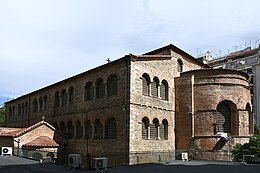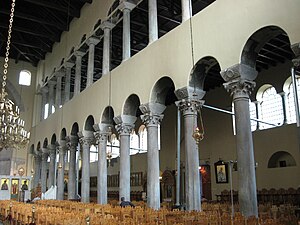Church of the Acheiropoietos
| UNESCO World Heritage Site | |
|---|---|
 The Church of the Acheiropoietos | |
| Location | Thessaloniki, Macedonia, Greece |
| Part of | Paleochristian and Byzantine monuments of Thessaloniki |
| Criteria | Cultural: (i), (ii), (iv) |
| Reference | 456-003 |
| Inscription | 1988 (12th Session) |
| Area | 0.375 ha (0.93 acres) |
| Coordinates | 40°38′5″N 22°56′52″E / 40.63472°N 22.94778°E |
The Church of the Acheiropoietos (
History and description
The Acheiropoietos has been dated from its bricks and mosaics to ca. 450–470, making it perhaps the earliest of the city's surviving churches. It was modified in the 7th and again in the 14th–15th centuries. Known as the
The building is a three-aisled basilica, some 28 m wide and 36.5 m long, with a wooden roof. Its eastern end is a semicircular vault, while on the western side a narthex, flanked by towers, and traces of an exonarthex survive. The three aisles are separated by columns, while the two side aisles have galleries above them. At the eastern end of the northern side aisle, a middle Byzantine chapel dedicated to St. Irene is attached. On the northwestern corner of the basilica, the stairway leading to the galleries survives. The current entrance is through a triple-arched opening (tribelon) that connects the narthex with the main nave, while on the southern side there is a monumental entranceway, which probably connected the church with the city's Byzantine-era thoroughfare. Another small adjoining building on the south side has been identified as the church's baptistery.[1][3] The modern roof is lower than the original, where the section above the central nave was elevated to allow light in.[5]
The surviving parts of the church's rich original interior decoration include particularly fine 5th-century
After
Gallery
-
Backside view of the church.
-
Roman era floor.
-
Interior.
-
Mosaic.
-
Interior.
References
- ^ a b c d e Αχειροποίητος, Hellenic Ministry of Culture (in Greek), retrieved 2010-04-23
- ^ "Paleochristian and Byzantine monuments of Thessaloniki". UNESCO World Heritage Convention. United Nations Educational, Scientific, and Cultural Organization. Retrieved 5 November 2022.
- ^ ISBN 978-0-19-504652-6
- ^ ISBN 960-7254-47-3
- ISBN 960-7254-47-3
- ISBN 978-0-19-504652-6
Further reading
- ISBN 9780870991790












